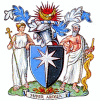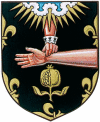The pomegranate was chosen as the logo for the Millennium Festival of Medicine from a shortlist that included DNA, the human body, and a heart beat. Not only has the pomegranate been revered through the ages for its medicinal properties but it also features in the heraldic crests of several medical institutions involved in the organisation of the festival.
Summary points
The pomegranate has been held sacred by many of the world's major religions
It has been revered through the ages for its medicinal properties
Preparations of different parts of the plant have been used to treat a variety of conditions
It features in the coat of arms of several medical associations
Sacred meanings
Before its medicinal properties were described the pomegranate was held sacred by many of the world's major religions.
In the Greek myth of Persephone's abduction by Hades, lord of the underworld, the pomegranate represents life, regeneration, and marriage.1 One day while out gathering flowers, Persephone noticed a narcissus of exquisite beauty. As she bent down to pick it, the earth opened and Hades seized her and dragged her down to his kingdom. By eating a few pomegranate seeds, Persephone tied herself to Hades—the pomegranate being a symbol of the indissolubility of marriage. Inconsolable at the loss of her daughter, the corn goddess Demeter prevented the earth from bearing fruit unless she saw her daughter again. Zeus intervened and worked out a compromise: Persephone should live with Hades for one third of the year and the other two thirds with Demeter. Persephone's return from the underworld each year is marked by the arrival of Spring.
Zoroastrianism
The pomegranate probably originated in Iran and Afghanistan and was much used in Zoroastrian ritual and domestic observances.2–3 In Persian mythology Isfandiyar eats a pomegranate and becomes invincible.4 In “The Persian War” Herodotus mentions golden pomegranates adorning the spears of warriors in the Persian phalanx.5
Judaism
Pomegranate seeds are said to number 613—one for each of the Bible's 613 commandments.6 The pomegranate was revered for the beauty of its shrub, flowers, and fruit—symbolising sanctity, fertility, and abundance.7 The Song of Solomon compares the cheeks of a bride behind her veil to the two halves of a pomegranate.8 Depictions of the fruit have long featured in architecture and design. They decorated the pillars of King Solomon's temple and the robes and regalia of Jewish kings and priests.
Buddhism
Along with the citrus and the peach, the pomegranate is one of the three blessed fruits. In Buddhist art the fruit represents the essence of favourable influences.9 In Buddhist legend the demoness Hariti, who devoured children, was cured of her evil habit by the Buddha, who gave her a pomegranate to eat. She is depicted in Buddhist art holding a child. In Japan she is known as Kishimojin and is invoked by infertile women.10
In China the pomegranate is widely represented in ceramic art symbolising fertility, abundance, posterity, numerous and virtuous offspring, and a blessed future.11 A picture of a ripe open pomegranate is a popular wedding present.
Christianity
A symbol of resurrection and life everlasting in Christian art, the pomegranate is often found in devotional statues and paintings of the Virgin and Child.
In medieval representations the pomegranate tree, a fertility symbol, is associated with the end of a unicorn hunt. The captured unicorn appears to be bleeding from wounds inflicted on him by the hunters.12 The “wounds” are actually pomegranate seeds dripping their blood red juices on his milk white body. Wild and uncontrollable by nature, unicorns can be tamed only by virgins. Once tamed, the unicorn was held in an enclosed garden and chained to a pomegranate tree, symbolising the impending incarnation of Christ.13
Islam
The heavenly paradise of the Koran describes four gardens with shade, springs, and fruits—including the pomegranate. Legend holds that each pomegranate contains one seed that has come down from paradise.5 Pomegranates have had a special role as a fertility symbol in weddings among the Bedouins of the Middle East.14 A fine specimen is secured and split open by the groom as he and his bride open the flap of their tent or enter the door of their house. Abundant seeds ensure that the couple who eat it will have many children.
Medicinal uses
Preparations of different parts of the plant—flower, fruit juice, rind, bark—have been used for a wide variety of conditions, although gastroenterological ailments predominate. Dioscorides describes some of them:
All sorts of pommegranats are of a pleasant taste and good for ye stomach . . . The juice of the kernells prest out, being sod and mixed with Hony, are good for the ulcers that are in ye mouth and in ye Genitalls and in the seate, as also for the Pterygia in digitis and for the Nomae and ye excrescencies in ulcers, and for ye paines of ye eares, and for the griefs in ye nosthrills . . . The decoction of ye flowers is a collution of moist flagging gummes and of loose teeth . . . ye rinde having a binding faculty . . . but ye decoction of ye roots doth expell and kill the Latas tineas ventris.”15
The use of pomegranate rind and root bark as a treatment for tapeworm infestation (“Latas tineas ventris”) was recommended by several early Roman medical writers and is still listed as a treatment for tapeworms and diarrhoea in a current encyclopaedia of medicinal plants.16
Heraldic uses
The British Medical Association and three royal colleges feature the pomegranate in their coats of arms. The pomegranate was part of Catherine of Aragon's coat of arms and was accepted into English heraldry when she married King Henry VIII in 1509. The Royal College of Physicians of London had adopted it in their coat of arms by the middle of the sixteenth century.17 The heraldic meanings of the pomegranate hark back to the meanings of the pomegranate in the myth of Persephone—the persistence of life, fertility, and regeneration.
Footnotes
Competing interests: None declared.
 British Medical Association
British Medical Association
 Royal College of Midwives
Royal College of Midwives
 Royal College of Obstetricians and Gynaecologists
Royal College of Obstetricians and Gynaecologists
 Royal College of Physicians
Royal College of Physicians
References
- 1.New Larousse encyclopedia of mythology. London: Hamlyn; 1983. [Google Scholar]
- 2.Trees at the Chelsea Physic Garden. London: Chelsea Physic Garden Company; 1997. p. 14. [Google Scholar]
- 3.Modi JJ. The religious ceremonies and customs of the Parsees. Bombay: British India Press; 1922. [Google Scholar]
- 4.Curtis VS. Persian myths. London: British Museum Press; 1996. p. 54. [Google Scholar]
- 5.Herodotus . The histories. London: Penguin; 1996. p. 389. [Google Scholar]
- 6.Good A, Nurock M. The fruits of the Holy Land. Jerusalem: Israel Universities Press; 1968. [Google Scholar]
- 7.Wigoder DE. The Garden of Eden cookbook. San Francisco: Harper & Row; 1988. [Google Scholar]
- 8.Holy Bible. Song of Solomon 4, 3.
- 9.Hall J. Hall's illustrated dictionary of symbols in eastern and western art. London: John Murray; 1995. [Google Scholar]
- 10.Munsterberg H. Dictionary of Chinese and Japanese art. New York: Hacker Art Books; 1981. p. 241. [Google Scholar]
- 11.Cooper JC. An illustrated encyclopaedia of traditional symbols. London: Thames and Hudson; 1995. p. 134. [Google Scholar]
- 12.Freeman MB. The unicorn tapestries. New York: Metropolitan Museum of Art; 1976. [Google Scholar]
- 13.Cherry J. Mythical beasts. London: British Museum Press; 1995. pp. 47–52. [Google Scholar]
- 14.Garrison W. Strange facts about the Bible. Nashville: Festival Books; 1980. p. 184. [Google Scholar]
- 15.Gunter RT. The Greek herbal of Dioscorides. Oxford: Oxford University Press; 1934. pp. 80–81. [Google Scholar]
- 16.Chevallier A. Encyclopedia of medicinal plants. London: Dorling Kindersley; 1996. p. 257. [Google Scholar]
- 17.Mason AS. The arms of the college. J R Coll Physicians Lond. 1992;26:231–232. [PMC free article] [PubMed] [Google Scholar]


